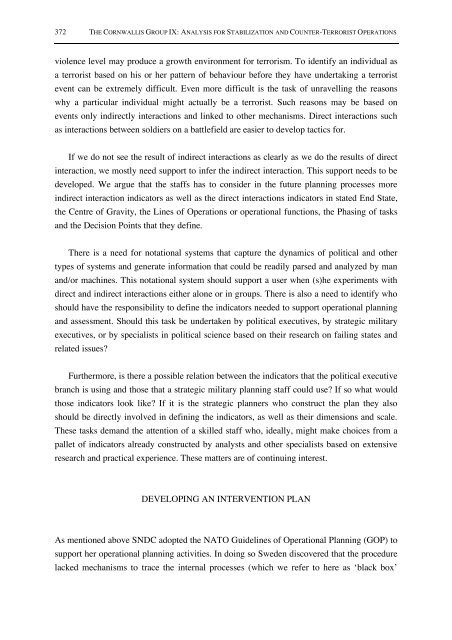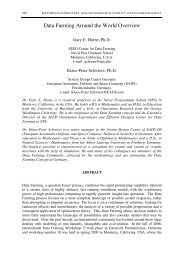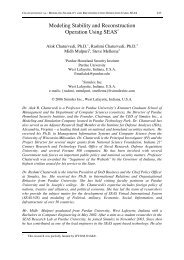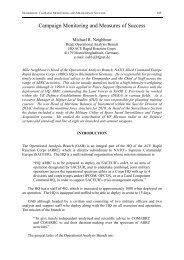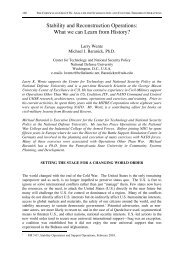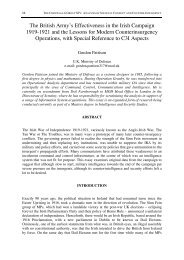Finding Robust Definitions for Feedback Stability ... - Cornwallis Group
Finding Robust Definitions for Feedback Stability ... - Cornwallis Group
Finding Robust Definitions for Feedback Stability ... - Cornwallis Group
You also want an ePaper? Increase the reach of your titles
YUMPU automatically turns print PDFs into web optimized ePapers that Google loves.
372 THE CORNWALLIS GROUP IX: ANALYSIS FOR STABILIZATION AND COUNTER-TERRORIST OPERATIONSviolence level may produce a growth environment <strong>for</strong> terrorism. To identify an individual asa terrorist based on his or her pattern of behaviour be<strong>for</strong>e they have undertaking a terroristevent can be extremely difficult. Even more difficult is the task of unravelling the reasonswhy a particular individual might actually be a terrorist. Such reasons may be based onevents only indirectly interactions and linked to other mechanisms. Direct interactions suchas interactions between soldiers on a battlefield are easier to develop tactics <strong>for</strong>.If we do not see the result of indirect interactions as clearly as we do the results of directinteraction, we mostly need support to infer the indirect interaction. This support needs to bedeveloped. We argue that the staffs has to consider in the future planning processes moreindirect interaction indicators as well as the direct interactions indicators in stated End State,the Centre of Gravity, the Lines of Operations or operational functions, the Phasing of tasksand the Decision Points that they define.There is a need <strong>for</strong> notational systems that capture the dynamics of political and othertypes of systems and generate in<strong>for</strong>mation that could be readily parsed and analyzed by manand/or machines. This notational system should support a user when (s)he experiments withdirect and indirect interactions either alone or in groups. There is also a need to identify whoshould have the responsibility to define the indicators needed to support operational planningand assessment. Should this task be undertaken by political executives, by strategic militaryexecutives, or by specialists in political science based on their research on failing states andrelated issues?Furthermore, is there a possible relation between the indicators that the political executivebranch is using and those that a strategic military planning staff could use? If so what wouldthose indicators look like? If it is the strategic planners who construct the plan they alsoshould be directly involved in defining the indicators, as well as their dimensions and scale.These tasks demand the attention of a skilled staff who, ideally, might make choices from apallet of indicators already constructed by analysts and other specialists based on extensiveresearch and practical experience. These matters are of continuing interest.DEVELOPING AN INTERVENTION PLANAs mentioned above SNDC adopted the NATO Guidelines of Operational Planning (GOP) tosupport her operational planning activities. In doing so Sweden discovered that the procedurelacked mechanisms to trace the internal processes (which we refer to here as ‘black box’


